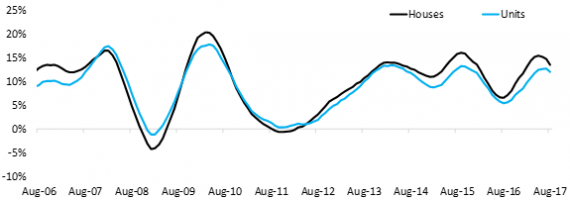- Home
- Home Loans
- News
- Easing returns from Aussie property
Easing returns from Aussie property

Australians are starting to see fewer returns from their property investments, according to new data from CoreLogic, with these returns forecast to further moderate over upcoming months.
CoreLogic’s Accumulation Index looks at the total returns from the housing asset class, factoring in the change in the value of the dwelling and the gross rental return from the property.

According to the Index, total returns from the housing asset class nationally over the 12 months to August 2017 were 13.2%. This is made up of total returns for housing (which tends to have superior value growth performance) at 13.5%, and total returns for units (which tends to have superior rental returns) at 12%.
While returns were seen to be slowing in both capital cities and regional markets, stronger returns were recorded in the city areas.

The strongest annual growth was recorded in Hobart, which also saw some of the highest rental yields, combining to deliver the strongest overall returns over the past 12 months. Double-digit total returns over the past year were recorded for houses in Sydney, Melbourne, Adelaide, Hobart and Canberra, and for units, double-digit total returns over the past year were seen in Sydney, Melbourne and Hobart. Units in Darwin were the only capital city property type to achieve negative returns over the past year.
According to CoreLogic head of research, Cameron Kusher, with capital growth now appearing to have peaked and rental yields at record lows it is reasonable to expect a further moderating of total returns over the coming months.
“The total returns data, particularly for the past decade, shows why housing investment has been so popular and hit record highs. Returns have been fairly consistent and less volatile than equities however, the ongoing strength and the evidence of a recent slowdown should give investors pause for thought.”
According to CoreLogic, factors contributing to the recent slowdowns in housing returns include increasing mortgage rates for investors and record-high levels of new housing supply. Also important to note are the increasing rents in many areas, which could make it more difficult for investors to secure tenants for 52 weeks a year, thus further complicating gross rental yield calculations.
Disclaimer
This article is over two years old, last updated on September 19, 2017. While RateCity makes best efforts to update every important article regularly, the information in this piece may not be as relevant as it once was. Alternatively, please consider checking recent home loans articles.
Compare home loans in Australia
Product database updated 06 Feb, 2025
Fact Checked
Share this page
Get updates on the latest financial news and products
By continuing, you agree to the RateCity Privacy Policy, Terms of Use and Disclaimer.








